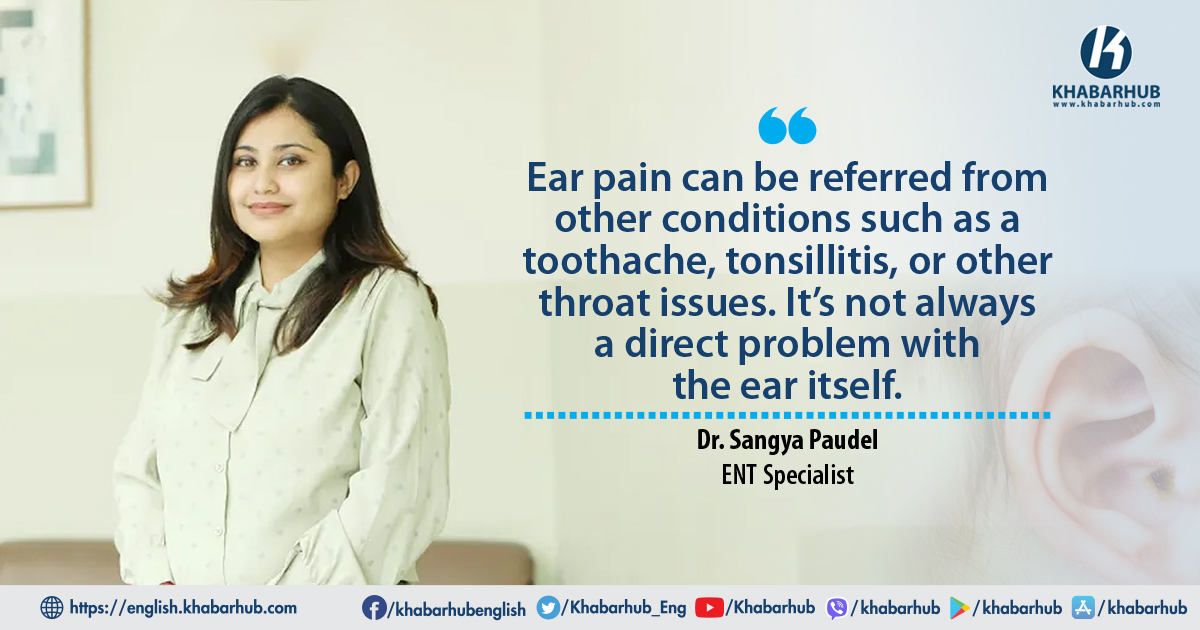KATHMANDU: The ear is a crucial part of the human body, and earaches are a common issue, particularly among young children.
While many people may consider ear pain to be a minor inconvenience and ignore it, the reality is that ear pain can vary in duration and intensity, from mild discomfort to severe agony.
According to medical experts, ear pain can stem not only from problems within the ear itself but also from issues in other parts of the body.
To understand more about the causes, seriousness, and treatment of ear pain, we spoke with Dr. Sangya Paudel, a specialist in nose, ear, and throat (ENT) conditions.
Ear pain is something many people experience, but understanding it can be complex. Can you help us break it down?
Absolutely. While everyone’s ears have similar structures, the causes of ear pain can vary widely. Pain can arise from different layers of the ear.
For example, some people experience pain due to skin infections on the outer ear, which is medically known as teloconjunctivitis.
What about infections in other parts of the ear?
Infections can also occur in the middle ear, involving the eardrum and ossicles, which is referred to as otitis media.
This condition is quite common and can lead to significant discomfort.
Additionally, congestion can cause earaches, which are often related to fluid build-up in the middle ear.
Are there specific symptoms that indicate where the problem might be?
Yes, problems in the outer ear are usually visible, but issues in the middle ear often manifest as pain and discomfort.
For children, this might be due to pus formation, inflammation, or perforation of the eardrum.
Earaches can also occur with a cold, as the nose, ear, and throat are interconnected through the same tube.
Can ear pain be a symptom of issues outside the ear itself?
Certainly. Ear pain can be referred from other conditions such as a toothache, tonsillitis, or other throat issues. It’s not always a direct problem with the ear itself.
How can one differentiate between normal ear pain and more serious conditions?
In children, a mild earache accompanying a cold might be normal. However, if the pain persists or affects the child’s ability to sleep, it warrants a visit to the hospital.
For older individuals, persistent ear pain combined with hearing issues could indicate an infection that may affect the brain if untreated, so timely medical intervention is crucial.
Do children of the same age experience earaches due to colds similarly?
Children under the age of five are more prone to ear infections because their ear structures are not fully developed.
Additionally, if a baby isn’t breastfeeding adequately, it can increase the risk of ear problems.
Milk can enter the ear through the tube connecting the nose and ear, potentially causing issues.
What kinds of ear problems are commonly seen in the hospital during this season?
During this season, with the increased risk of viral infections, we’re seeing a lot of cases of ringing in the ears.
Additionally, many patients are experiencing congestion due to a combination of water and oil in the ears.
This issue is particularly prevalent during the rainy season when water mixes with the oil some people use for ear care.
You mentioned oil affecting ear health. What should be done when a child’s ears are dry?
When a child’s ears are very dry, applying a drop or two of oil occasionally can help. However, we must be cautious, as we can’t always see what’s happening inside the ear.
If there is a perforation in the eardrum, applying oil could worsen the situation. It’s generally advisable to avoid putting oil directly into the inner ear to prevent the risk of infection.
A small amount applied to the outer ear can help keep it moisturized without causing harm.
What are some common causes of a hole in the eardrum?
A hole in the eardrum, or tympanic membrane, can be caused by untreated pus accumulation.
If the pus is not cleaned out in time, it can rupture the eardrum. Sometimes, the eardrum may heal on its own, but often, the hole remains untreated.
Additionally, trauma to the ear, such as being hit, can cause a perforation. Another issue is bone erosion in the ear, which can lead to pus discharge and a foul odor.
This condition, though it might not be painful initially, can affect the brain and requires prompt treatment.
Besides pain and swelling, what other symptoms might indicate a hole in the eardrum?
Sometimes, a hole in the eardrum might not present with pain or swelling.
Patients might come in with hearing loss, and upon examination, a perforation may be discovered. It’s possible for the hole to be asymptomatic, and patients might not be aware of it until it’s identified during a medical evaluation.
What is the recommended treatment for a hole in the eardrum?
Treatment depends on the severity of the perforation. If there is active pus discharge, it can be managed with medication to address the infection.
However, if the hole in the eardrum does not heal on its own, surgical intervention may be required to repair the eardrum.
Prompt treatment is essential to prevent complications and ensure proper healing.
What steps can people take to avoid ear pain?
To prevent ear pain, several practices can be beneficial. First and foremost, it’s important to avoid the habit of picking your ears.
This can cause irritation and damage, affecting everything from the outer ear to the inner eardrum.
Are there any other precautions people should take?
Yes, many people turn to medication as soon as they catch a cold, which can sometimes lead to ear infections. It’s better to manage colds carefully and consult a healthcare provider if needed.
Additionally, for parents, it’s advisable not to feed babies while they are lying flat. If you need to feed a baby during sleep, try to elevate their head slightly with a pillow to reduce the risk of ear infections.
What about treating frequent earaches?
Frequent earaches, whether in children or adults, should be addressed promptly.
Delaying treatment can lead to more serious issues, so it’s important to seek medical advice as soon as symptoms arise to prevent complications.









Comment